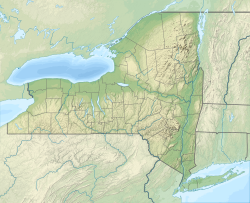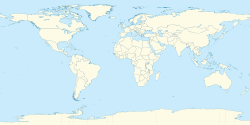
Albany, New York
Capital city of New York, United States / From Wikipedia, the free encyclopedia
Dear Wikiwand AI, let's keep it short by simply answering these key questions:
Can you list the top facts and stats about Albany, New York?
Summarize this article for a 10 year old
Albany (/ˈɔːlbəni/ ⓘ AWL-bə-nee) is the capital and oldest city in the U.S. state of New York, and the seat of and most populous city in Albany County. It is located on the west bank of the Hudson River, about 10 miles (16 km) south of its confluence with the Mohawk River.
Downtown Albany skyline from Rensselaer State Quad at SUNY Albany | |
| Etymology: Named for the Scottish Duke of Albany, whose title comes from the Gaelic name for Scotland: Alba | |
Nicknames:
| |
| Motto: Assiduity[lower-alpha 4] | |
 Boundaries of and major thoroughfares through Albany | |
 Location of Albany in Albany County (upper left) and of Albany County in the State of New York (lower right) | |
| Coordinates: 42°39′09″N 073°45′26″W | |
| Country | United States |
| State | New York |
| Region | Capital District |
| County | Albany |
| Settled | 1614; 410 years ago (1614) |
| Incorporated | 1686; 338 years ago (1686) |
| Government | |
| • Type | Strong mayor-council |
| • Mayor | Kathy Sheehan (D) |
| Area | |
| • State capital | 21.94 sq mi (56.81 km2) |
| • Land | 21.40 sq mi (55.44 km2) |
| • Water | 0.53 sq mi (1.38 km2) |
| • Metro | 2,811.6 sq mi (7,282 km2) |
| Elevation | 148 ft (45 m) |
| Highest elevation | 378 ft (115 m) |
| Lowest elevation | 2 ft (0.6 m) |
| Population (2020) | |
| • State capital | 99,224 |
| • Estimate (2023) | 101,228 (US: 331st) |
| • Density | 4,730.28/sq mi (1,825.9/km2) |
| • Urban | 593,142 (US: 73rd) |
| • Urban density | 2,186.3/sq mi (844.1/km2) |
| • Metro | 1,170,483 (US: 63rd) |
| • Metro density | 416.3/sq mi (160.7/km2) |
| Demonym | Albanian[12] |
| Time zone | UTC−5 (EST) |
| • Summer (DST) | UTC−4 (EDT) |
| ZIP Codes | 12201–12212, 12214, 12220, 12222–12232 |
| Area codes | 518, 838 |
| Geocode | 977310, 978659 |
| ISO 3166 code | 36-01000 |
| FIPS code | 36-01000 |
| GNIS feature ID | 977310[10] |
| Website | albanyny.gov |
The city has a rich history, and is known for its architecture, commerce, culture, and institutions of higher education. It is the economic and cultural core of the Capital District of the State of New York, which comprises the Albany–Schenectady–Troy Metropolitan Statistical Area, including the nearby cities and suburbs of Troy, Schenectady, and Saratoga Springs. With an estimated population of 1.1 million in 2013, the Capital District is the third most populous metropolitan region in the state. As of 2022, Albany's population was 100,826.
The Hudson River area was originally inhabited by Algonquian-speaking Mohican (Mahican).[13] The area was settled by Dutch colonists, who built Fort Nassau in 1614 for fur trading and Fort Orange in 1624. In 1664, the English took over the Dutch settlements, renaming the city Albany in honor of the Duke of York's Scottish title, the Duke of Albany, which takes it name from Alba, the Scottish Gaelic name for Scotland.[14] The Duke of Albany would later become James II of England and Ireland and James VII of Scotland.[15] The city was officially chartered in 1686 under English rule. It became the capital of New York in 1797 after the formation of the United States. Albany is the oldest surviving settlement of the original British thirteen colonies north of Virginia. No other city in the United States has been continuously chartered as long.[16]
In the late 18th century and throughout most of the 19th, Albany was a center of trade and transportation. The city lies toward the north end of the navigable Hudson River. It was the original eastern terminus of the Erie Canal, connecting to the Great Lakes, and was home to some of the earliest railroads in the world. In the 1920s a powerful political machine controlled by the Democratic Party arose in Albany. In the latter part of the 20th century, Albany's population shrank because of urban sprawl and suburbanization. In the 1990s, the New York State Legislature approved for the city a US$234 million building and renovation plan, which spurred redevelopment downtown.[17] In the early 21st century, Albany's high-technology industry grew, with great strides in nanotechnology.[18][19]












